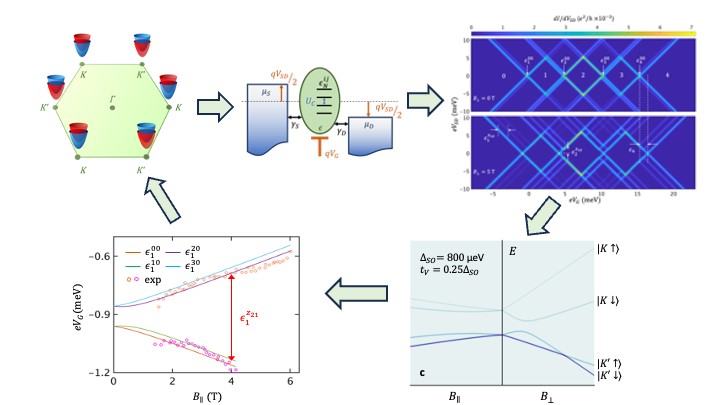SFB 1432 Colloquium: Unifying recent experiments on spin-valley quantum states in TMDC quantum dots
Time
Thursday, 27. June 2024
15:15 - 16:30
Location
P 603
Organizer
SFB 1432, G. Burkard
Speaker:
Prof. Dr. Bhaskaran Muralidharan, IIT Bombay
Unifying recent experiments on spin-valley quantum states in TMDC quantum dots
Recent experiments on spin-valley locking in transition metal di-chalcogenides (TMDC) quantum-dot platforms [1-3] have opened new avenues for spin and valley-qubit processing [4,5]. Starting from the basic tenets of quantum transport theory [6,7], we present a unified simulation platform to interpret the ground and excited state transport spectroscopy data [1-3] obtained under the diverse experimental conditions. In doing so, we reveal vital operating conditions under which spin-valley locking occurs, thereby closing the loop on how to connect to the material properties under these conditions. Specifically, we pinpoint the role of intervalley mixing, the number of monolayers and the varying electrostatic environments. Most importantly, by providing near exact theoretical fits of the ground and excited state spectroscopy data [1-3], we conclude that the degree of spin-valley locking indeed increases with a decrease in the number of monolayers.
As a corollary, the analysis of the relevant Fock-subspaces in the simulated transport spectroscopy also reveals that, contrary to what is currently recognized, the out-of-plane g-factor depends on the number of electrons in the dot and also on the relative strength of magnetic field in comparison with the spin-orbit coupling strength. We believe that our work provides an enabling platform for a predictable theory-aided experimental realisation of spin and valley qubit processing on various 2D-material quantum dot platforms.
We conclude the talk with an overview of our current research works in the area of topological electronics, making a digression from quantum dots into non-interacting and conjugated systems, spanning applications for low-power electronics and valleytronics [8-10].
[1]. P. Kumar, H Kim, S Tripathy, K Watanabe, T Taniguchi, KS Novoselov, D Kotekar-Patil, Nanoscale, 45, 18203, (2023).
[2]. T. R. Devidas, I. Keren and H. Steinberg, Nano Lett., 21, 6931, (2021).
[3]. R. Krishnan, S. Biswas, Y-L Hsueh, H. Ma, R. Rahman and B. Weber, Nano Lett., 23, 6171 (2023).
[4] András Pályi and Guido Burkard, Phys. Rev. Lett. 106, 086801 (2011).
[5]. A. Kormányos, V. Zólyomi, N. D. Drummond, and G. Burkard, Phys. Rev. X 4, 011034, (2014).
[6] S. Datta, Quantum Transport: Atom to transistor, Cambridge Univ. Press, (2005).
[7] A. Mukherjee and B. Muralidharan, 2D Materials, 10, 035006, (2023).
[8] K. Jana and B. Muralidharan, npj 2D Mat. and Applications, 6, 19, (2022).
[9] S. Banerjee, K. Jana, A. Basak, M. S. Fuhrer, D. Culcer and B. Muralidharan, Phys. Rev. Applied, 18, 054088, (2022).
[10] S. Midha, K. Jana and B. Muralidharan, New J. Phys., 57, 135308, (2024).

